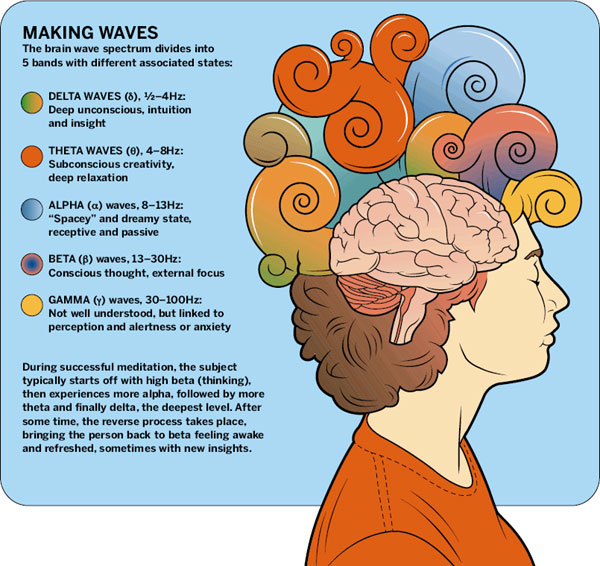
*Update via The New York Times: “Do you have chronic sleep problems? You may be able to significantly improve your ability to get a restful night of sleep by practicing a popular form of meditation, a rigorous new study shows.” the full article.
~
One of the main causes of insomnia is that our minds are so busy racing with thoughts that it’s difficult to relax enough to enter into a gentle sleep.
When the mind is in this state, even when we do fall asleep, we will most likely reawaken many times throughout the night.
A peaceful nights sleep has many significant benefits. Not only will we awaken feeling refreshed, our immune systems also receive a boost. While asleep, our bodies set to work repairing any damage that has been done throughout the day—skin, muscles, brain cells and blood are all regenerated.
Depriving the body of this vital process lowers serotonin, which is thought to be responsible for headaches, depression, anxiety, violence and various other behavioural related problems.
After a full night’s sleep we will feel rejuvenated, look better, feel better and be more productive in every task throughout the day.
Once we learn to fully relax, we can then move into a meditative state and sleep will come naturally.
When we break down the process into stages, from relaxation through to meditation, then sleep, it is easier to identify the differences between each one.
Relaxation is the art of fully loosening the body and mind. When we are relaxing we are still engaged in the thought process. Our minds will still wander and thoughts will constantly come and go.
Meditation occurs when we learn to let go of all thoughts and be fully present in the moment. Our minds should be still so that we can achieve a deeper sense of awareness and inner peace.
Sleep is a period of rest where the body is not active and the mind is not fully conscious.
There are four main types of brainwave activity, and most people use meditation to achieve an alpha brainwave frequency to fully experience the benefits of a heightened euphoric state.
Beta: Our regular, conscious stage.
Alpha: The state between the conscious mind and sleep.
Theta: Where we enter into a trace like stage when our mind is at its most creative and we can experience an altered stage of consciousness.
Delta: This is when we are in our deepest levels of sleep.
While Theta is believed to be the most common brainwave frequency reached while practicing meditation, Delta is thought to be able to be reached by more experienced practitioners to access the unconscious mind.
Cultivating mindfulness in meditation can assist in alleviating any negativity from the mind and replace negative thoughts with positive ones.
Mindfulness is, quite simply, being in the present moment, being aware of our thoughts and actions in a non-judgemental way. By refraining from any past or present thinking we can bring ourselves back to the here and now. When this happens, we will be concentrating fully on whatever it is that we are doing in that moment, without the mind frantically jumping back and forth.
Mindfulness takes practice, like anything, but the more it is practiced the more natural it will become.
To begin the process of meditation, the most important thing is to get completely comfortable. If low lighting is preferable, then turn lights down low. Set the room temperature to a comfortable level—if the body is too cold, it will feel tense and it becomes much more difficult to relax fully.
Gentle music can be played in the background to provide a more serene environment. There are plenty of CDs available and also various options available on YouTube or similar sites.
Move into whatever position feels most comfortable to meditate. For many, when using it to promote sleep, lying down on the bed can be the perfect option as it saves any movement when we are relaxed enough to enter sleep. This is the posture that I will be covering here. However, choose whatever position suits you. It is a personal experience, and everyone has their own preference.
The Meditation:
Position
Lying on the back, spread both arms out at either side. Palms of the hands should face up and slightly away from the body. Legs are fully stretched out and the feet are hip width apart. Check in with each part of the body to make sure it is fully comfortable. Scan from top to toe and notice how each part is feeling. Keep adjusting slightly if needed.
If this is not comfortable, move to a supported chair and relax into it. Gently squeeze and then release each area of the body, starting with the toes, and then work your way up eventually focusing on each part of the head. Eyes, mouth, cheeks are all areas that are sometimes tense and can be forgotten. Relax deep into the surface the body is resting on and let it take the full weight of your torso, head and limbs.
Mindful Breathing
Begin to pay attention to the breathing pattern. Notice how the body and organs feel as each breath is processed. Focus on the sensation of the lungs filling and emptying. Feel the air move through the nostrils with each deep inhale and exhale. Some people like to count each breath as a way of keeping the concentration on breathing and not on anything else passing through the mind.
Thoughts
One of the biggest myths people have about meditation is that they have to completely empty the mind before beginning. A calm state of mind will come naturally and is not to be forced. Allow each thought to enter the mind, pay attention to it for a very short period and then let it go. Try not to attach any emotion to your thinking, just recognize whatever is floating around and then release it. Keeping thoughts on your breathing and how your body is feeling will within time take any focus away from anything else trying to enter the mind.
Visualise
Focusing the mind on a specific scene can help to alleviate any other unwelcome thoughts occurring. Focusing on a colour, a sunset, a favourite object or just about any image that will bring about a greater sense of calm. Try to hold the image in the mind and combining breathing to gently flow into a deeper meditation.
Now, lie still allowing the body and mind to feel all the sensations that are taking place. Do not rush any part of this process. Just let the meditation naturally progress.
Feel the sense of stillness wash over the body as the mind enters a place of calm and tranquillity. The entire body will be entering into a deep sense of relaxation and then gently into a meditative state.
While moving through each stage of consciousness, try to remain as still as possible in body and mind. Allow the mind to transcend naturally through each change that takes place.
As you reach that feeling of sleepiness, allow it to gently take place. Some people like to awaken gently before drifting back to sleep. Choose whatever feels best for you.
The most important thing about it is to enjoy how it feels for, appreciate the changes that are occurring within and only practice whatever feels comfortable. It is a very personal experience and the above is a guideline, each person will find their own natural way in discovering what feels right for them.
This process can be repeated at any time during the day or at night, or after a particularly stressful day. The more regular it is practiced, the deeper the meditative state will be.
References:
~ Alex Sandra Myles
Love elephant and want to go steady?
Sign up for our (curated) daily and weekly newsletters!
Editor: Emily Bartran
Image: Google Images for Reuse


Read 4 comments and reply